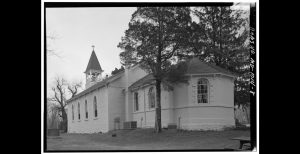
Description
Sacred Heart Roman Catholic Church and Cemetery was originally known as White Marsh Plantation. It was given to the Jesuits as a bequest in 1729 by James Carroll, cousin of John Carroll who later became the first Roman Catholic Archbishop of Baltimore. By 1741, The Jesuits had taken possession and built the original chapel.
White Marsh contained about 2,000 acres at its height and was one of several Jesuit-owned properties in central and southern Maryland. Each Jesuit manor or plantation was organized in a similar fashion with a home farm, plantation fields, and numerous tenant farms. The home farm served as the home of the Jesuit priests and brothers. As a former Jesuit Plantation, it stands as a testament to the early history of the Catholic Church in Maryland and the significant role that slavery played in the history of the Catholic Church. At times, as many as 100 enslaved men, women, and children lived at White Marsh with the Jesuit priests, brothers, and seminarians. The infamous 1838 sale of 272 Jesuit enslaved included 89 of the people enslaved at White Marsh.
Sacred Heart Roman Catholic Church is significant as one of three former Jesuit plantations that today is an active parish church. Beginning in 1783, a series of meetings, known as General Chapters, were held at White Marsh for the purpose of organizing the Roman Catholic Church in the new United States. It was at one of these meetings that then-Fr. John Carroll, SJ was nominated to become Prefect Apostolic, the head of the Church in the United States, and later as the first Archbishop of Baltimore. The creation of what is today Georgetown University was discussed and decided at these meetings, which were held in the chapel.
The chapel, house, and novitiate buildings perished in a fire in 1853. The current chapel was rebuilt inside the stone walls that remained after the fire. Today the parish uses a new church completed in 1969 but retains the original site of the home farm and chapel of the plantation. The Cemetery is cared for by an active group of descendants. See White Marsh Historical Society
Additional Resources
https://stillwespeak.org website
The 272: The Families Who Were Enslaved and Sold to Build the American Catholic Church, Rachel Swarns (book)
Jesuit Slaveholding in Maryland, 1717-1838, Thomas Murphy, S.J. (book)
Life and Labor Under the Georgetown Slavery Project: White Marsh
SMR: Descendants Georgetown University Project avery memory reconciliation descendant group
History of the White Marsh Property
Medusa https://apps.mht.maryland.gov/Medusa/PDF/PrinceGeorges/PG;71A-19.pdf